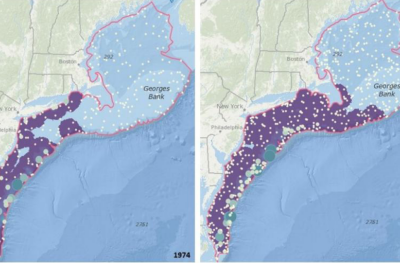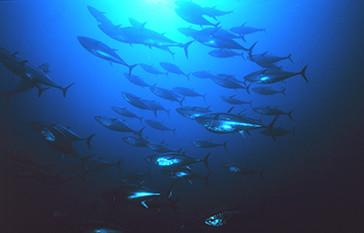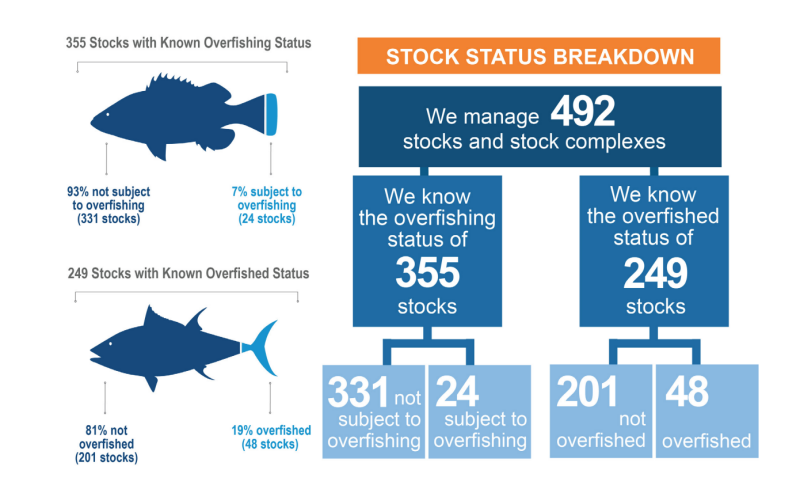The annual National Marine Fisheries Service “Status of Stocks” report says the agency and its eight regional fishery management council continue to show slow, steady results in rebuilding U.S. fish stocks to sustainable levels.
This latest fisheries scorecard summarizes 2022 results, notching findings for 492 fish stocks and stock complexes managed under federal law.
“In 2022, the number of stocks on the overfishing list decreased slightly, the number of overfished stocks also slightly decreased, and two stocks were rebuilt,” the report states in opening. “We continue to implement management measures that will end overfishing, rebuild overfished stocks, and sustain our fisheries for future generations.”
The paper offers an explanation of how NMFS has been calculating the overall state of U.S. fisheries since the overarching federal law – the Magnuson-Stevens Fishery Conservation and Management Act – was authorized by Congress in 1996.
As defined in the report, a stock is considered “overfished” when it is being harvested at a rate faster than what biologists calculate would produce its maximum sustainable yield, or MSY.
An “overfished” stock has a population size that is too low, jeopardizing the stock’s ability to produce its MSY.
A “rebuilt” stock is one that was previously overfished, and now has abundance is now at the managers’ ideal target population size to support maximum sustainable yield.
“Of the stocks most targeted by fishermen, 88 percent have a known overfishing or overfished status,” the report notes up high. But that does not equate to looming disaster.
“In 2022, 90 percent of all stocks or complexes did not exceed their annual catch limits,” the report states. “When catch limit overages occur, NMFS and the Councils take steps to ensure overages do not continue. Annually monitoring catch levels and working to keep them within acceptable limits paired with taking corrective measures when limits are exceeded, helps reduce the chance of overfishing and ensures long-term biological and economic sustainability.”
The annual balance sheet from the National Oceanic and Atmospheric Administration’s fisheries service is just a snapshot that only captures an overview of complex deliberations between the agency, its regional management councils, and what is happening out on the ocean. One example is Gulf of Maine haddock, which was added to the “overfishing” category in 2022.
But haddock is not technically overfished. In recent days – before the status report came out – the New England Fishery Management Council asked NMFS for an emergency action to allow a temporary quota increase for Gulf of Maine haddock when the 2023 groundfish season opens May 1. Fishermen advised the council that haddock catches have been bigger than expected, raising the prospect of early shutdowns this summer.
Changing climate conditions complicate the outlook across the board for many species. Warming waters off the U.S. Mid-Atlantic and Northeast states have gradually nudged the black sea bass population northward – opening potential opportunities for commercial fishing off southern New England.

But warming waters appear to be delaying other stock rebuilding plans.
“While we have successfully rebuilt 49 stocks over the last 20 years, rebuilding stocks to historical levels has become more challenging due to climate change and other factors,” the report says. For example, waters off the northeastern United States are among the fastest warming in the world’s oceans, causing shifts in the distribution of many fish stocks and decreasing reproductive capacity.”
“Under a rebuilding plan that began in 2004, the Cape Cod/Gulf of Maine yellowtail flounder population size increased and the stock rebuilt to its sustainable target level,” the NMFS report notes. “Conversely, the Southern New England/Mid-Atlantic winter flounder population size has significantly decreased since the beginning of its rebuilding plan, despite fisheries management actions to control fishing mortality.
“Due to changing environmental conditions and lower stock productivity, scientists concluded that the target population level should be changed to a lower target.”
Along with winter flounder, the stunning closing of Alaska’s Bering Sea crab fisheries, shrinking of Atlantic cod and “and continued poor recruitment of South Atlantic gag grouper demonstrate some of the challenges of managing fisheries in the face of climate change,” the report says.
“Advances such as accurately predicting stock conditions, tracking species distribution, and incorporating environmental data into stock assessments help address these challenges and are leading the way toward climate-resilient fisheries.”
Pacific bluefin tuna is one success story highlighted by the NMFS report. International effort by the U.S. and other nations have turned around what once was a depleted stock, and large numbers of young tuna promise a speeding recovery, the report says.

“Ten years ago, the Pacific bluefin tuna population was a small fraction of its historical size. NOAA’s investment in research that supported reducing fishery catch on younger fish to increase biomass proved successful,” the report states. “A recent stock assessment co-developed by NOAA scientists shows that the stock is no longer subject to overfishing and is recovering faster than anticipated.”
During 2022 NMFS also implemented new island-based fishery management plans for Puerto Rico, St. Thomas and St. John, and St. Croix.
“This action consolidated four existing Caribbean fishery management plans into three island-based plans and added 32 stocks and stock complexes to our list of managed stocks,” the report notes.
“The island-based fishery management plans account for the differences between fishing sectors, available markets for harvested products, fishermen and their fishing communities, and the social and cultural attributes unique to each island area.”
In terms of overall national economic impact, commercial fishermen in 2021 harvested over 8.5 billion pounds of seafood valued at $6.3 billion, according to the report.
On the recreational side, saltwater angling in 2020 generated $98 billion in sales impacts, contributed $55 billion to the gross domestic product, and supported 595,000 jobs in the marine recreational fishing industry and across the broader economy.
“Compared to 2019, these numbers represent an increase for recreational fisheries, but a notable decrease for commercial fisheries, primarily due to safety measures put in place for the covid-19 pandemic,” the report says.
“Also in 2020, U.S. commercial fisheries and the seafood industry generated $47 billion in sales impacts, contributed $24.4 billion to the gross domestic product, and supported 588,000 jobs.”







